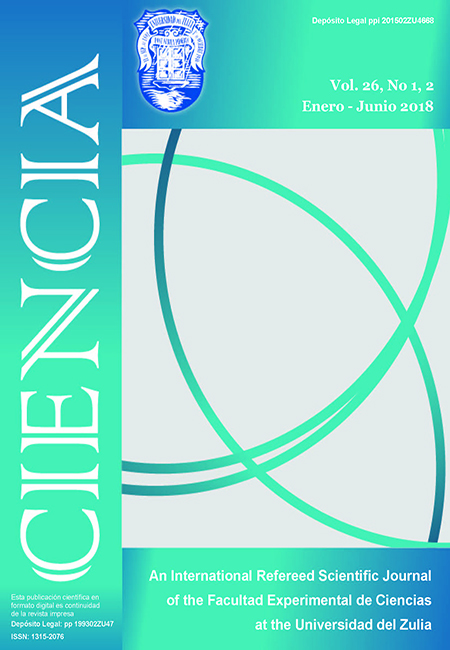Characterization of lytic-specific phages ofPseudomonas aeruginosawith a broad infective spectrum
Caracterización de fagos líticos-específicos de Pseudomonas aeruginosa con un amplio espectro infectivo
Abstract
Pseudomonas aeruginosa is an opportunity pathogen that may become multiresistant to antibiotics. Hence, it is necessary to consider alternative medical procedure using antipseudomonal agents like bacteriophages. Their lytic enzymes with bactericidal actions have been widely utilized to control this type of microorganisms. Screening of 50 samples of wastewater from of Zulia state was performed to evaluate bacteriophages’ antagonistic activity on P. aeruginosa. The samples were pre-enriched and the supernatants were filtered, purified and stored. Detection was performed by double layer agar. The strain P. aeruginosaATCC®27853 was used as a host, and several microorganisms, both Gram positive and Gram negative, were used to establish infective profile. Antipseudomonic phages’ biological cycle and stability to pH and temperature variations were evaluated. Antipseudomonic phages were detected in 60% of the samples. 85% of the isolates managed to infect all strains of P. aeruginosa. 80% of the phages were adsorbed in <10min after being exposed to the host. All phages were stable at various pH and temperature ranges. There were no apparent changes in lysis plate morphology. The phages had characteristics that make them possible members of the order Caudovirales and potential antagonistic agents against multiresistant pathogens such as P. aerugino
Downloads
References
RICE S., VAN DEN AKKER B., FRANCESCO D. J. Water Health 10: 181-196. 2012.
HILL D., ROSE B., PAJKOS A., ROBINSON M., BYE P., BELL S., HARBOUR, C. J. Clin. Microbiol. 43(10): 5085-5090. 2005.
RICE L. J Infect Dis 197(8): 1079-1081. 2008.
EL DIDAMONY G., ASKORA A., SHEHATA A. Curr. Microbiol. 70(6): 786-791. 2015.
CHATTERJEE M., ANJU C. P., BISWAS L., KUMAR V. A., MOHAN C. G., BISWAS R. Int. J. Med. Microbiol. 306(1): 48-58. 2016.
SCHOOLEY R. T., BISWAS B., GILL J. J., HERNANDEZ-MORALES, A. LANCASTER, J. LESSOR, L., SEGALL, A. M. Antimicrob. Agents Chemother. 61(10): e00954-17. 2017.
ZHANG Y., HU Z. Biotechnol. Bioeng. 110(1): 286-295. 2013
KNEZEVIC P., OBREHT, D. PETROVIC O. Curr. Microbiol. 59(2): 173-180. 2009.
AHIWALE S., PRAKASH D., GAJBHIYE M. JAGDALE, S. PATIL, N., KAPADNIS B. Curr. Microbiol. 64(4): 305-311. 2012.
PIRES D., VILAS BOAS D., SILLANKORVA S., AZEREDO J. Infections. Virol. 89:7449 –7456.
DEL CASTILLO C., GÓMEZ A., NOÉ M. Manual de laboratorio. Prácticas de virología. FMVZ-UNAM. México DF (México). 2003.
GAVIRIA, A., GONZÁLEZ, M., CASTAÑO, O. Rev. MVZ Córdoba 17(1): 2852-2860. 2012.
BEDOYA L., BUSTAMANTE A., JURADO A., NIÑO C., ZAMBRANO C., VERGEL Z. A., PORTILLA L., NAVIA D., GAVIRIA A., ALBORNOZ G. Aislamiento y detección de bacteriófagos específicos para Pseudomona sp obtenidos a partir de muestras de tierra. Universidad Del Quindio. Armenia (Colombia). 2013.
KNEZEVIC P., OBREHT D., PETROVIC O. Curr. Microbiol. 59(2): 173-180. 2009.
CEYSSENS J., NOBEN P., ACKERMANN W., VERHAEGEN J., DE VOS D., PIRNAY P., MERABISHVILI M., VANEECHOUTTE M., CHIBEU A., VOLCKAERT G., LAVIGNE R. Environ. Microbiol. 11(5): 1303-1313. 2009.
COMISIÓN VENEZOLANA DE NORMAS INDUSTRIALES (COVENIN). Norma N° 2986-93. 1993.
LEGNANI P., LEONI E., RAPUANO S., TURIN D., VALENTI C. Int. J. Food Microbiol. 53(2- 3):153-158. 1999.
-PAYARES B., VILLASMIL F., MATOS R., LARREAL Á., BARBOZA Y., LEVY A. Multiciencias 13(1): 16-22. 2013.
PRADA, C., HOLGUIN, A., GONZÁLEZ, A., VIVES, M. Univ. Sci. (Pontif. Univ. Javeriana, Fac. Cienc.) 20(1): 43-59. 2015.
CONCEPCIÓN R., VÁZQUEZ M., LÓPEZ R. Rev. AquaTIC 18:3-10. 2003.
Jensen E., Schrader H., Rieland B., Thompson T., Lee K., Nickerson K., Kokjohn T. Appl. Environ. Microbiol. 64(2): 575-580. 1998.
DINI C. Aislamiento y caracterización molecular de bacteriófagos de bacterias enteropatógenas para biocontrol de enfermedades transmitidas por alimentos (Para obtener el título de Doctor en Ciencias Exactas). Facultad de Ciencias Exactas. Universidad Nacional de La Plata. Buenos Aires (Argentina) 142pp. 2011.
GUTTMAN, B., RAYA, R., KUTTER, E. Basic phage biology. En: KUTTER, E. Y A. SULAKVELIDZE
(eds) Bacteriophages: Biology and Applications. CRC Press. New York (USA). 29-66. 2004.
FORTIER L., MOINEAU S. Phage production and maintenance of stocks, including expected stocks lifetimes. En: CLOKIE M., KROPINSKI A. (eds) Bacteriophages: Methods and Protocols, Volume 1: Isolation, Characterization, and Interactions. Humana Press. Michigan (USA). 203-219. 2009.
BERNHARDT G., WANG N., STRUCK K., YOUNG R. Science 292(5525): 2326-2329. 2001.
MANIV I., JIANG W., BIKARD D., MARRAFFINI L. J. Bacteriol. 198(6): 941-950. 2016.
AMITAI G., SOREK R. Nat. Rev. Microbiol. 14(2): 67-76. 2016.
MAXWELL K. PLoS Pathog. 12(1): e1005282. 2016.
LANDER E. Cell 164(1): 18-28. 2016.
SPRICIGO D. La desinfección basada en bacteriófagos como herramienta de biocontrol de Salmonella en alimentos (para obtener el título de Doctor en Ciencias). Facultat de Biociències. Universitat Autònoma de Barcelona. Barcelona (España). 181pp. 2011.
TANJI Y., SHIMADA T., FUKUDOMI H., MIYANAGA K., NAKAI Y., UNNO H. J. Biosci. Bioeng. 100(3): 280-287. 2005.
RUSSO, T. Capsule and Lipopolysaccharide. En: DONNENBERG M. S. (ed). Escherichia coli: virulence mechanisms of a versatile pathogen. Academic Press. Boston (USA). 379-403 pp. 2002.
HASSAN A., FRANK J. Int. J. Food Microbiol. 96(1): 103-109. 2004.
SHARMA M., RYU J., BEUCHAT J. J. Appl. Microbiol. 99(3): 449-459. 2005.
ABEDON T. Bacteriophage ecology: population growth, evolution, and impact of bacterial viruses. Cambridge University Press. New York (USA). 508 pp. 2008.
SEGUNDO A., HERNÁNDEZ E., LÓPEZ O., TORRES O. Rev. Mex. Cienc. Farm. 41(3): 17- 26. 2010.
DE SMET J., ZIMMERMANN M., KOGADEEVA M., CEYSSENS P., VERMAELEN W., BLASDEL B., HO B., JANG U.; LAVIGNE R. ISME J. 10(8):1823- 1835. 2016.












